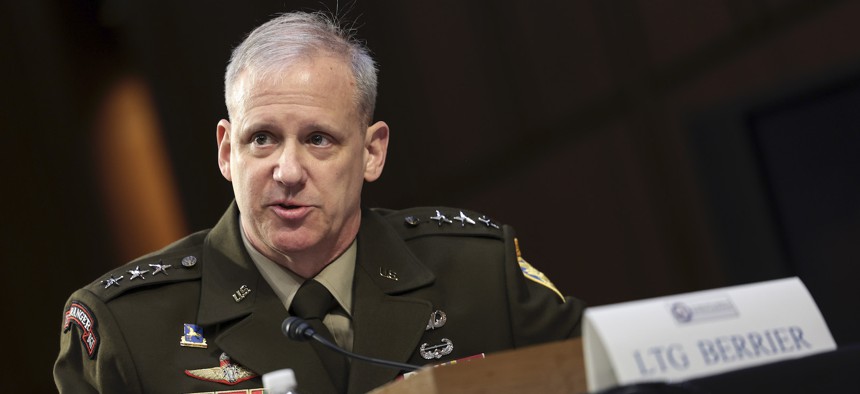
Defense Intelligence Agency (DIA) Director Lt. General Scott Berrier testify before the Senate Intelligence Committee on March 10, 2022 in Washington, DC. The committee held a hearing on worldwide threats. Photo by Kevin Dietsch/Getty Images
Learn from Ukraine, DIA Chief Tells New China Mission Group
Defense Intelligence Agency unit takes aim at “warning problem of our lifetime.”
Lessons from Ukraine will inform a new China mission group intended to be “a single visible place” for the Defense Intelligence Agency’s leaders, partners, and other agencies to get information about the People’s Liberation Army, DIA’s chief of staff said Tuesday.
DIA director Lt. Gen. Scott Berrier wants to “take the lessons learned from the Russia-Ukraine crisis, particularly as it...relates to indications and warning, and apply that to China, China-Taiwan- type scenarios,” John Kirchhofer said at an INSA event. “This is a warning problem of our lifetime.”
The group, which includes members of the agency’s analysis and science and technology directorates, is already operating in a limited form today and will reach full operating capability in the spring, Kirchhofer said.
“This is us integrating to the maximum extent possible on an existential threat to the long-term success of the United States,” Kirchhofer said.
Ukraine offers a lot of lessons for the intelligence community. On the one hand, their willingness to declassify intel and warn the world about the impending invasion inspired a raft of sanctions on Moscow and a flood of aid to Kyiv. On the other hand, the Biden administration officials were so convinced that Russia would tear through Ukraine’s military that they tried to persuade Ukrainian President Volodymyr Zelensky to leave the country. What that suggests is that leaders operating with the best available intelligence drastically overestimated the strength of the Russian military and underestimated that of Ukraine.
“Those predictions, based on alluring but fundamentally flawed criteria, have now proved false,” University of St. Andrews professor Phillips Payson O’Brien wrote in March. “Western analysts took basic metrics (such as numbers and types of tanks and aircraft), imagined those measured forces executing Russian military doctrine, then concluded that the Ukrainians had no chance. But counting tanks and planes and rhapsodizing over their technical specifications is not a useful way to analyze modern militaries.”
O’Brien called Ukraine’s resilience “embarrassing for a Western think-tank and military community that had confidently predicted that the Russians would conquer Ukraine in a matter of days.”
In May, Berrier acknowledged that he hadn’t factored in Ukraine’s resolve. “My view was that, based on a variety of factors, that the Ukrainians were not as ready as I thought they should be,” he told the Senate Armed Services Committee. “Therefore, I questioned their will to fight. That was a bad assessment on my part because they have fought bravely and honorably and are doing the right thing.”
Taiwan poses a similar murky challenge. It is moving to acquire anti-access capabilities—drones, long-range fires, naval mines—in accordance with their Overall Defense Concept. Those should be useful in deterring a Chinese invasion, However, assessing Taiwan’s resolve in the face of multiple scenarios, from naval blockade to full-scale military occupation of Taipei, is a matter of understanding not only capability but also–far more ephemerally–will.
Like other defense agencies, DIA is moving more personnel and tech to U.S. Indo-Pacific Command’s area of responsibility, Kirchhofer said.
“We're already working with partners for partners and U.S. partners to get our footprint pushed into that region,” he said.
Lauren Williams contributed to this post.


